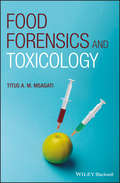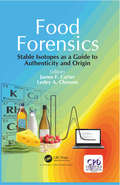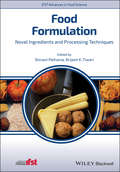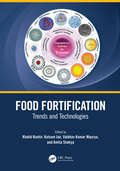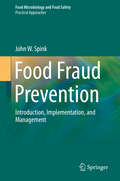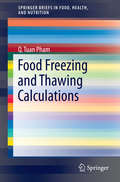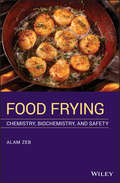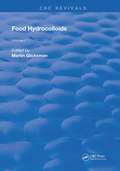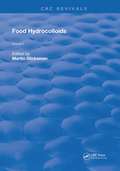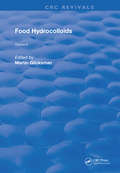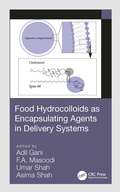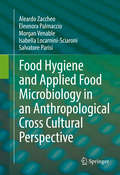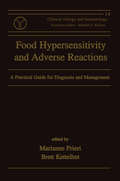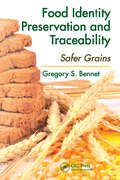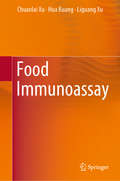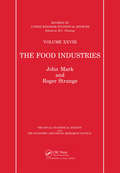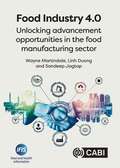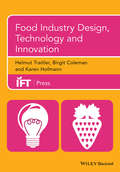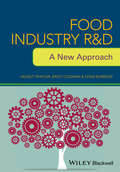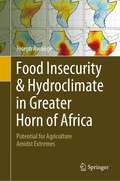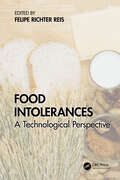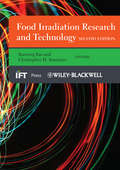- Table View
- List View
Food Forensics and Toxicology
by Titus A. MsagatiA comprehensive guide, offering a toxicological approach to food forensics, that reviews the legal, economic, and biological issues of food fraud Food Forensics and Toxicology offers an introduction and examination of forensics as applied to food and foodstuffs. The author puts the focus on food adulteration and food fraud investigation. The text combines the legal/economic issues of food fraud with the biological and health impacts of consuming adulterated food. Comprehensive in scope, the book covers a wide-range of topics including food adulteration/fraud, food "fingerprinting" and traceability, food toxicants in the body, and the accidental or deliberate introduction of toxicants into food products. In addition, the author includes information on the myriad types of toxicants from a range of food sources and explores the measures used to identify and quantify their toxicity. This book is designed to be a valuable reference source for laboratories, food companies, regulatory bodies, and researchers who are dealing with food adulteration, food fraud, foodborne illness, micro-organisms, and related topics. Food Forensics and Toxicology is the must-have guide that: Takes a comprehensive toxicological approach to food forensics Combines the legal/economic issue of food fraud with the biological/health impacts of consuming adulterated food in one volume Discusses a wide range of toxicants (from foods based on plants, animals, aquatic and other sources) Provides an analytical approach that details a number of approaches and the optimum means of measuring toxicity in foodstuffs Food Forensics and Toxicology gives professionals in the field a comprehensive resource that joins information on the legal/economic issues of food fraud with the biological and health implications of adulterated food.
Food Forensics: Stable Isotopes as a Guide to Authenticity and Origin
by James F. Carter Lesley A. ChessonFood forensics is a multi-disciplinary science involving advanced analytical techniques, plant and animal metabolism, and sophisticated data interpretation tools. This book explains how plants, and in turn animals eating those plants, assimilate stable isotopes and trace elements from their environments. It provides extensive reviews of the use of stable isotope and trace element measurements for the authentication of major food groups and how these can be used to detect fraudsters. The book emphasises the use of correct methods for sample preparation and measurement so that data can be compared to existing datasets, with a dedicated chapter discussing interpretations.
Food Formulation: Novel Ingredients and Processing Techniques (IFST Advances in Food Science)
by Brijesh K. Tiwari Shivani PathaniaReviews innovative processing techniques and recent developments in food formulation, identification, and utilization of functional ingredients Food Formulation: Novel Ingredients and Processing Techniques is a comprehensive and up-to-date account of novel food ingredients and new processing techniques used in advanced commercial food formulations. This unique volume will help students and industry professionals alike in understanding the current trends, emerging technologies, and their impact on the food formulation techniques. Contributions from leading academic and industrial experts provide readers with informed and relevant insights on using the latest technologies and production processes for new product development and reformulations. The text first describes the basis of a food formulation, including smart protein and starch ingredients, healthy ingredients such as salt and sugar replacers, and interactions within the food components. Emphasizing operational principles, the book reviews state-of-the-art 3D printing technology, encapsulation and a range of emerging technologies including high pressure, pulsed electric field, ultrasound and supercritical fluid extraction. The final chapters discuss recent developments and trends in food formulation, from foods that target allergies and intolerance, to prebiotic and probiotic food formulation designed to improve gut health. A much-needed reference on novel sourcing of food ingredients, processing technologies, and application, this book: Explores new food ingredients as well as impact of processing on ingredient interactions Describes new techniques that improve the flavor and acceptability of functional food ingredients Reviews mathematical tools used for recipe formulation, process control and consumer studies Includes regulations and legislations around tailor-made food products Food Formulation: Novel Ingredients and Processing Techniques is an invaluable resource for students, educators, researchers, food technologists, and professionals, engineers and scientists across the food industry.
Food Fortification: Trends and Technologies
by Khalid Bashir, Kulsum Jan, Vaibhav Kumar Maurya, and Amita ShakyaIn a world that is constantly evolving, our understanding of nutrition and its impact on human health has grown exponentially. Food, once merely a source of sustenance, is now recognized as a powerful tool for improving public health and well-being. Organized into four sections, Food Fortification: Trends and Technologies presents a comprehensive exploration of food fortification—from its historical roots to its modern applications.Part I introduces the concept of food fortification as a potential strategy for the control of micronutrient malnutrition and the role of micronutrients in human health, recommended dietary allowance, and source. It also details the deficiency, prevalence, populations under risk, and factors contributing to micronutrient deficiency. Part II summarizes the prevalence, causes, and consequences of vitamin deficiencies. It lays a framework for national and international fortification programs. In addition, it provides information about case studies, the impact of fortification on food textural and sensory properties, as well as challenges with currently used fortification methods. Part III provides technical information on various minerals that can be used to fortify foods, including their chemistry, absorption, metabolism, and biological role. It also reviews their applications in specific food vehicles. Part IV describes the key steps involved in food bioactive fortification. This section also deals with the fortification of multigrain flour and challenges associated with PUFA fortification. It also highlights the important roles of encapsulation on bioavailability, with examples of fortification in dairy, egg, bakery, confectionery, and other products. This book delves into the critical realm of fortifying our food supply to address the complex nutritional challenge and is a tribute to the progress that has been made in food fortification over the past few decades, as well as a call to action for the work that still lies ahead.
Food Fraud Prevention: Introduction, Implementation, and Management (Food Microbiology and Food Safety)
by John W. SpinkThis textbook provides both the theoretical and concrete foundations needed to fully develop, implement, and manage a Food Fraud Prevention Strategy. The scope of focus includes all types of fraud (from adulterant-substances to stolen goods to counterfeits) and all types of products (from ingredients through to finished goods at retail). There are now broad, harmonized, and thorough regulatory and standard certification requirements for the food manufacturers, suppliers, and retailers. These requirements create a need for a more focused and systematic approach to understanding the root cause, conducting vulnerability assessments, and organizing and implementing a Food Fraud Prevention Strategy. A major step in the harmonizing and sharing of best practices was the 2018 industry-wide standards and certification requirements in the Global Food Safety Initiative (GFSI) endorsed Food Safety Management Systems (e.g., BRC, FSSC, IFS, & SQF). Addressing food fraud is now NOT optional – requirements include implementing a Food Fraud Vulnerability Assessment and a Food Fraud Prevention Strategy for all types of fraud and for all products. The overall prevention strategy presented in this book begins with the basic requirements and expands through the criminology root cause analysis to the final resource-allocation decision-making based on the COSO principle of Enterprise Risk Management/ ERM. The focus on the root cause expands from detection and catching bad guys to the application of foundational criminology concepts that reduce the overall vulnerability. The concepts are integrated into a fully integrated and inter-connected management system that utilizes the Food Fraud Prevention Cycle (FFPC) that starts with a pre-filter or Food Fraud Initial Screening (FFIS). This is a comprehensive and all-encompassing textbook that takes an interdisciplinary approach to the most basic and most challenging questions of how to start, what to do, how much is enough, and how to measure success.
Food Freezing and Thawing Calculations
by Q. Tuan PhamFreezing time and freezing heat load are the two most important factors determining the economics of food freezers. This Brief will review and describe the principal methods available for their calculation. The methods can be classified into analytical methods, which rely on making physical simplifications to be able to derive exact solutions; empirical methods, which use regression techniques to derive simplified equations from experimental data or numerical calculations and numerical methods, which use computational techniques such as finite elements analysis to solve the complete set of equations describing the physical process. The Brief will evaluate the methods against experimental data and develop guidelines on the choice of method. Whatever technique is used, the accuracy of the results depends crucially on the input parameters such as the heat transfer coefficient and the product's thermal properties In addition, the estimation methods and data for these parameters will be reviewed and their impacts on the calculations will be evaluated. Freezing is often accompanied by mass transfer (moisture loss, solute absorption), super cooling and nucleation and may take place under high pressure conditions; therefore methods to take these phenomena into account will also be reviewed.
Food Frying: Chemistry, Biochemistry, and Safety
by Alam ZebA wide-ranging exploration of the science and practice of food frying Frying is one of the world’s most popular methods of food preparation. Whether using oils or fats, it is valued for the particular flavors and textures it can bring, and represents a multibillion-dollar sector of the global economy. Food Frying: Chemistry, Biochemistry and Safety explores this important cooking technique in its scientific dimensions, charting the relationships between the chemical reactions produced during frying, the changes in food quality that these engender, and associated digestive and health-related issues. By outlining these connections, the author provides an aid to a safer, healthier approach to food frying. Topics covered range from culturally specific forms of frying to detailed analyses of the chemical and biochemical processes involved in its practice. Delivering these insights in a practical and easy-to-follow manner, this unique text includes: A complete survey of food frying, encompassing cultural, chemical, biochemical, and toxicological concerns Guidance on the accurate assessment of health, quality, and safety issues associated with food frying Coverage of the latest technologies and methods involved with frying Information on the possible future development of fried foods Food Frying: Chemistry, Biochemistry and Safety is an invaluable resource for all those who work with fried foods, whether they be food industry professionals, food scientists, or workers in the oil and fat industries.
Food Hydrocolloids (Routledge Revivals #1)
by Martin GlicksmanFirst Published in 1982, this three-volume set explores the value of hydrocolloids in food. Carefully compiled and filled with a vast repertoire of notes, diagrams, and references this book serves as a useful reference for dieticians and other practitioners in their respective fields.
Food Hydrocolloids (Routledge Revivals #2)
by Martin GlicksmanFirst Published in 1982, this three-volume set explores the value of hydrocolloids in food. Carefully compiled and filled with a vast repertoire of notes, diagrams, and references this book serves as a useful reference for dieticians and other practitioners in their respective fields.
Food Hydrocolloids (Routledge Revivals #3)
by Martin Glicksman Steen Højgaard Christensen Joseph A. Grover Carl T. Herald John D. Keller Christopher McIntyre William R. ThomasFirst Published in 1982, this three-volume set explores the value of hydrocolloids in food. Carefully compiled and filled with a vast repertoire of notes, diagrams, and references this book serves as a useful reference for dieticians and other practitioners in their respective fields.
Food Hydrocolloids as Encapsulating Agents in Delivery Systems
by Adil Gani F. A. Masoodi Umar Shah Shah AsimaThis book addresses the use of food hydrocolloids as agents for encapsulating biological active ingredients. It details the challenges of poorly-controlled rate of hydration, thickness, decrease in viscosity upon storage, and susceptibility to microbial contamination. Food Hydrocolloids as Encapsulating Agents in Delivery Systems briefly describes various emerging biomaterials including food gums, starches, beta glucans, and proteins for their potential role as wall material in the development of nutraceutical delivery systems. Further, it describes different techniques of fabrication of nanodelivery systems. Features: Provides an introduction to food hydrocolloids as encapsulating agents Covers starches and their derivatives as delivery systems Includes gum-based delivery systems Discusses the classification, isolation, and purification of protein delivery systems This book would be helpful to food scientists and pharmaceutical scientists working in areas including nanotechnology, polymer chemistry, and nutraceutical delivery, as well as regulators and government researchers in US FDA, USDA, and UK FSA regulatory agencies.
Food Hydrocolloids: Functionalities and Applications
by Katsuyoshi Nishinari Yapeng Fang Hongbin ZhangThe book introduces the definition, classification, source and structure of hydrocolloids and provides a comprehensive description of their functionalities and food-related applications. The emphasis is put on the basic concepts and mechanisms underlying functionalities, and the new developments in fundamental knowledge and practice. The book would be useful for students or professionals working in the fields of food science & technology, and biopolymers etc. It would help to organize hydrocolloids knowledge in a more systematic framework and enlighten further profound investigations.
Food Hygiene and Applied Food Microbiology in an Anthropological Cross Cultural Perspective
by Salvatore Parisi Aleardo Zaccheo Eleonora Palmaccio Morgan Venable Isabella Locarnini-Sciaroni#65533;The book demonstrates that food safety is a multidisciplinary scientific discipline that is specifically designed to prevent foodborne illness to consumers. It is generally assumed to be an axiom by both nonprofessionals and professionals alike, that the most developed countries, through their intricate and complex standards, formal trainings and inspections, are always capable of providing much safer food items and beverages to consumers as opposed to the lesser developed countries and regions of the world. Clearly, the available data regarding the morbidity and the mortality in different areas of the world confirms that in developing countries, the prevalence and the incidence of presumptive foodborne illness is much greater. However, other factors need to be taken into consideration in this overall picture: First of all, one of the key issues in developing countries appears to be the availability of safe drinking water, a key element in any food safety strategy. Second, the availability of healthcare facilities, care providers, and medicines in different parts of the world makes the consequences of foodborne illness much more important and life threatening in lesser developed countries than in most developed countries. It would be therefore ethnocentric and rather simplistic to state that the margin of improvement in food safety is only directly proportional to the level of development of the society or to the level of complexity of any given national or international standard. Besides standards and regulations, humans as a whole have evolved and adapted different strategies to provide and to ensure food and water safety according to their cultural and historical backgrounds. Our goal is to discuss and to compare these strategies in a cross-cultural and technical approach, according to the realities of different socio-economic, ethnical and social heritages.
Food Hypersensitivity and Adverse Reactions: A Practical Guide for Diagnosis and Management
by Marianne FrieriPresents classic and recent findings on immunological dysfunctions caused by food allergies-coordinating the most advanced clinical techniques and assessment methods with practical insights for treatment and patient care.
Food Identity Preservation and Traceability: Safer Grains
by Gregory S. BennetA Practical Roadmap to IPT IntegrationFrom baby formula and peanut butter, to E. coli-tainted peppers and salmonella-tainted pistachios, no food product or means of its production is immune to risks. And while these risks may never be fully eliminated, identity preservation and traceability (IPT) systems make it easier to determine the source and e
Food Immunoassay
by Chuanlai Xu Hua Kuang Liguang XuThis book systematically covers immunoassays for food, presenting detailed approaches such as antigen design, food matrix pre-treatment and detection format optimization for 9 classes of food hazards and nutrition constituents. Offering ideas on how to improve the efficiency of recognized xenobiotics and food contents, this practical book also describes the discovery and utilization of novel immune agents like aptamer and molecular imprinted polymers in food analysis. It is intended for a broad range of areas, including biologists and food chemists, and is sure to become a key reference resource for students and professionals alike.
Food Industries
by J. Mark R. Strange J. BurnsThis volume deals with the diverse range of industries concerned with the supply and processing of food in the UK. It covers sources relating to food production and processing, including foodstuffs supplied from abroad, and also fish supply and processing.
Food Industry 4.0: Unlocking Advancement Opportunities in the Food Manufacturing Sector
by Dr Wayne Martindale Dr Linh Duong Dr Sandeep JagtapThis book provides industry insights and fresh ideas for the advancement of the most vital global industry - food. Drawing on their industry and academic expertise the authors have identified three controlling aspects of food business operations that can unleash long term success: consumer health and wellbeing; product and process sustainability; and harnessing advances in digitalization.. If developed to their maximum potential these factors have the capability to revolutionize the food sector. Food Industry 4.0 highlights advancement opportunities for the food manufacturing sector, including innovation in products, processes and services, as it seeks to combine productive, efficient and sustainable practices. The contents address: Mapping data, new approaches for food system applications. The perfect meal and making a balanced global diet possible. Industry 4.0 applications in the food sector: robotics and automation, big data, Internet of Things, cybersecurity. Resource utilization in the food manufacturing sector. Resilience and sustainability in food supply chains. Environmental and social governance in our food system. It is of significant benefit to food industry practitioners working in operational and product development roles, academic researchers, policy makers, students, and food sector professionals.
Food Industry Design, Technology and Innovation
by Helmut Traitler Birgit Coleman Karen HofmannFood products have always been designed, but usually not consciously. Even when design has been part of the process, it has often been restricted to considerations of packaging, logos, fonts and colors.But now design is impacting more dramatically on the complex web that makes up our food supply, and beginning to make it better. Ways of thinking about design have broad applications and are becoming central to how companies compete. To succeed, food designers need to understand consumers and envision what they want, and to use technology and systems to show they can deliver what has been envisioned. They also need to understand organizations in order to make innovation happen in a corporation.The authors of this book argue that design has been grossly underestimated in the food industry. The role of design in relation to technology of every kind (materials, mechanics, ingredients, conversion, transformation, etc.) is described, discussed, challenged and put into proper perspective. The authors deftly analyze and synthesize complex concepts, inspiring new ideas and practices through real-world examples. The second part of the book emphasizes the role of innovation and how the elements described and discussed in the first parts (design, technology, business) must join forces in order to drive valuable innovation in complex organizations such as large (and not so large) food companies.Ultimately, this groundbreaking book champions the implementation of a design role in defining and executing business strategies and business processes. Not only are designers tremendously important to the present and future successes of food corporations, but they should play an active and decisive role at the executive board level of any food company that strives for greater success.
Food Industry Quality Control Systems
by Mark CluteWith more than 100 tables, spreadsheets, and program outlines, Food Industry Quality Control Systems features all of the systems needed for food manufacturing facilities to assure food quality and safety. This book outlines the role of management in overall quality control and the role of HACCP within a company. It explains the basics of quality control programs including pest control programs, lot coding, organizational charts, specifications, supplier certification, and sanitation programs. Readers can visit the CRC website to download supporting programs in a "plug-and-play" format and adaptable forms with specific examples and resources that enable companies to customize forms to fit their own needs.
Food Industry R&D: A New Approach
by Helmut Traitler Birgit Coleman Adam BurbidgeResearch and development represents a vast spread of topics and can be an arena for controversy. In academia, such controversy may stem from conflicting interpretations of data and subsequent conclusions, the question of who was first to discover a particular finding and whether or not the said finding is of any value to the scientific community. R&D in corporate environments is mostly defined and driven by costs and clearly identified, consumer-focused targets. There is, however, common ground between these two approaches as both strive to maximize knowledge, though for different reasons and in differnt ways. The equipment and scientific rigor may be similar or identical, however their usage, approach and interpretation are different. This book discusses the history and background of today's food industry R&D as seen by consumers, academia and the industry itself, with several chapters dedicated to new and disruptive approaches. A must-read for all professionals in the packaged goods industry as well as students who aspire to contribute to this new industry, forcefully driven by R&D.
Food Insecurity & Hydroclimate in Greater Horn of Africa: Potential for Agriculture Amidst Extremes
by Joseph AwangeThis book will benefit users in food security, agriculture, water management, and environmental sectors. It provides the first comprehensive analysis of Greater Horn of Africa (GHA)’s food insecurity and hydroclimate using the state-of-the-art Gravity Recovery and Climate Experiment (GRACE) and its Follow-on (GRACE-FO)’s, centennial precipitation, hydrological models’ and reanalysis’ products. It is here opined that GHA is endowed with freshwater (surface and groundwater) being home to the world's second largest freshwater body (Lake Victoria) and the greatest continental water towers (Ethiopian Highlands) that if properly tapped in a sustainable way, will support its irrigated agriculture as well as pastoralism. First, however, the obsolete Nile treaties that hamper the use of Lake Victoria (White Nile) and Ethiopian Highland (Blue Nile) have to be unlocked. Moreover, GHA is bedevilled by poor governance and the ``donor-assistance” syndrome; and in 2020-2021 faced the so-called ``triple threats’’ of desert locust infestation, climate variability/change impacts and COVID-19 pandemic. Besides, climate extremes influence its meagre waters leading to perennial food insecurity. Coupled with frequent regional and local conflicts, high population growth rate, low crop yield, invasion of migratory pests, contagious human and livestock diseases (such as HIV/AIDs, COVID-19 & Rift Valley fever) and poverty, life for more than 310 million of its inhabitants simply becomes unbearable. Alarming also is the fact that drought-like humanitarian crises are increasing in GHA despite recent progress in its monitoring and prediction efforts. Notwithstanding these efforts, there remain challenges stemming from uncertainty in its prediction, and the inflexibility and limited buffering capacity of the recurrent impacted systems. To achieve greater food security, therefore, in addition to boosting GHA's agricultural output, UN Office for the Coordination of Humanitarian Affairs suggest that its “inhabitants must create more diverse and stable means of livelihood to insulate themselves and their households from external shocks”. This is a task that they acknowledge will not be easy as the path ahead is “strewn with obstacles namely; natural hazards and armed conflicts”. Understanding GHA’s food insecurity and its hydroclimate as presented in this book is a good starting point towards managing the impacts of the natural hazards on the one hand while understanding the impacts associated with extreme climate on GHA's available water and assessing the potential of its surface and groundwater to support its irrigated agriculture and pastoralism would be the first step towards “coping with drought” on the other hand.The book represents a significant effort by Prof Awange in trying to offer a comprehensive overview of the hydroclimate in the Greater Horn of Africa (GHA). Prof Eric F. Wood, NAE (USA); FRSC (Canada); Foreign member, ATSE (Australia).
Food Insecurity and Public Health
by Louise IversAffecting more than 800 million people, food insecurity is a global problem that runs deeper than hunger and undernutrition. In addition to the obvious impact on physical well-being, food insecurity can result in risky coping strategies, increased expenditures on medical costs or transportation, and mental health issues. A review of the concepts an
Food Intolerances: A Technological Perspective
by Felipe Richter ReisWhile modern food production has become increasingly efficient in providing a wide range of convenient and affordable products, individuals struggling with gluten intolerance, FODMAP intolerance, and intolerance to food additives are an exception when their health conditions limit the foods they can safely eat. Food intolerances, usually dealt with from a health perspective, also have technological aspects, especially as one takes into consideration that foods designed for individuals with food intolerances require specific ingredients, formulations, and processing conditions.Food Intolerances: A Technological Perspective addresses the health and food science aspects of food intolerances from a technological perspective, which is rarely considered in other books. Valuable data on products and production processes for designing foods for people who have food intolerances are presented in a way that various types of food industries can benefit from.Key Features: Compiles health and food science aspects of food intolerances in a single location Addresses clean label food products and links them to food additive intolerances Discusses the mechanisms behind the changes in food product quality after ingredient substitution and compound removal in gluten-free, low-FODMAP, and clean label products Provides perspectives and future trends in the development of food products for people who have food intolerances A compilation of research from prominent medical doctors and PhDs in food science from around the world, this book is helpful for food science students and industry professionals alike.
Food Irradiation Research and Technology (Institute of Food Technologists Series #68)
by Christopher H. Sommers Xuetong FanThe benefits of food irradiation to the public health have been described extensively by organizations such as the Centers for Disease Control and Prevention in the USA and the World Health Organization. The American Medical Association and the American Dietetic Association have both endorsed the irradiation process. Yet the potential health benefits of irradiation are unknown to many consumers and food industry representatives who are wary of irradiated foods due to myth-information from “consumer-advocate” groups. This updated second edition of Food Irradiation Research and Technology reviews the latest developments in irradiation technologies as they are applied to meat, seafood fish, fruits, vegetables and nuts. Experts from industry, government, and academia define the basic principles and public health benefits of irradiation. New chapters in this edition address irradiation chemistry, including furan formation due to irradiation, irradiation of packaging materials, processing irradiation technologies and parameters, and ready-to-eat meat products. Coverage of safety and quality of fresh fruits and vegetables, phytosanitary applications and consumer acceptance has been expanded to address recent interest and development. The book is designed to appeal to a broad readership: industry food scientists involved in the processing of meat and fish, fruits and vegetables; food microbiologists and radiation processing specialists; and government and industry representatives involved in the import and export of food commodities.
